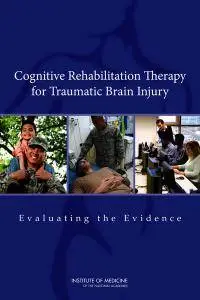"Cognitive Rehabilitation Therapy for Traumatic Brain Injury: Evaluating the Evidence" ed. by Rebecca Koehler, Erin Wilhelm, Ira Shoulson
Committee on Cognitive Rehabilitation Therapy for Traumatic Brain Injury; Institute of Medicine Authoring Organizations
NAS Press | 2011 | ISBN: 0309218187 9780309218184 | 258 pages | PDF | 3 MB
Committee on Cognitive Rehabilitation Therapy for Traumatic Brain Injury; Institute of Medicine Authoring Organizations
NAS Press | 2011 | ISBN: 0309218187 9780309218184 | 258 pages | PDF | 3 MB
This issue is a study to determine the effectiveness of cognitive rehabilitation therapy for treatment of Traumatic brain injury.
Traumatic brain injury (TBI) may affect 10 million people worldwide. It is considered the "signature wound" of the conflicts in Iraq and Afghanistan. These injuries result from a bump or blow to the head, or from external forces that cause the brain to move within the head, such as whiplash or exposure to blasts.
TBI can cause an array of physical and mental health concerns and is a growing problem, particularly among soldiers and veterans because of repeated exposure to violent environments. One form of treatment for TBI is cognitive rehabilitation therapy (CRT), a patient-specific, goal-oriented approach to help patients increase their ability to process and interpret information.
Contents
ACRONYMS AND ABBREVIATIONS
SUMMARY
PART I: BACKGROUND
1 INTRODUCTION
Scope of the Report
Traumatic Brain Injury
Consequences of TBI
Treatment
The Military Health System
Conclusion
References
2 TRAUMATIC BRAIN INJURY
Classification Schemes
Heterogeneity
Measures of Outcome
Conclusion
References
3 FACTORS AFFECTING RECOVERY
Pre-Injury Conditions
Comorbidities
Contextual Factors
Conclusion
References
4 DEFINING COGNITIVE REHABILITATION THERAPY
The Breadth of Rehabilitation
An Evolving Definition of CRT
Conclusion
References
5 STATE OF PRACTICE AND PROVIDERS OF COGNITIVE REHABILITATION THERAPY
State of Practice
Providers
Conclusion
References
6 METHODS
Literature Review 6-1
Evaluation of the Evidence
Quality of Study Designs
Organization of the Evidence Chapters
References
7 ATTENTION
Overview
Moderate-Severe TBI
Conclusions: Attention
References
8 EXECUTIVE FUNCTION
Overview
Awareness
Conclusions: Awareness
Non-Awareness
Conclusions: Non-Awareness
References
9 LANGUAGE AND SOCIAL COMMUNICATION
Overview
Chronic, Moderate-Severe TBI
Conclusions: Language and Social Communication
References
10 MEMORY
Overview
Internal Memory Strategies
External Memory Strategies
Combined Memory Strategies: Internal and External
Restorative Strategies
Conclusions: Memory
References
11 MULTI-MODAL OR COMPREHENSIVE CRT
Overview
Subacute Phase of Recovery
Conclusions: Subacute, Multi-Modal/Comprehensive CRT
Chronic Phase of Recovery
Conclusions: Chronic, Multi-Modal/Comprehensive CRT
References
12 TELEHEALTH TECHNOLOGY
Overview
CRT Applied Through Telehealth Technology
Conclusions: Telehealth Technology
References
13 ADVERSE EVENTS OR HARM
Overview
Potential for Adverse Events or Harm from CRT
Conclusions: Adverse Events or Harm
References
PART III: RECOMMENDATIONS
14 DIRECTIONS
Synthesis of Evidence Review
Recommendations
Conclusion
References
APPENDIXES
A Comparative Effectiveness and Implementation Research for Neurocognitive Disorders
B Workshop Agendas
C Recent and Ongoing Trials
D Biosketches of Committee Members and Staff
with TOC BookMarkLinks



